Estimated reading time: 20 minutes
Crop rotation is the practice of changing the types of crops planted in a given area from one year to the next. The reason is that repeated planting of the same plant in the same spot every year leads to nutrient depletion in the soil and increases the potential for insects and diseases. It also helps with soil aeration and moisture retention.
Where It All Began
It’s hard to pinpoint the exact place and time where crop rotation first occurred, but it’s believed that the ancient Romans and possibly the ancient Greeks first discovered the practice.
What became apparent to ancient farmers was that planting the same crop in the same place over the seasons resulted in smaller plant growth, more disease, and lower yields.
Perhaps it was a decision to simply plant something else to satisfy a new need that led to the discovery that changing the crop or “rotating” them would result in better plant growth.
Want to save this post for later? Click Here to Pin It On Pinterest!

It’s Not About the Size of Your Garden
Whether you’re planting a small garden in your backyard or numerous acres on a homestead, crop rotation makes sense even on a small scale. Most of what we’ll cover is for a home gardens, but we’ll cover the more ambitious crops that some of us might plant across acres.
We'll also show you some simple charts or graphs you can make to plan your crop rotation. This is especially important for small-scale home gardens where multiple vegetable varieties may share the same garden space.
It will make it easier to remember what goes where year after year and will reward you with better yields and healthier plants.
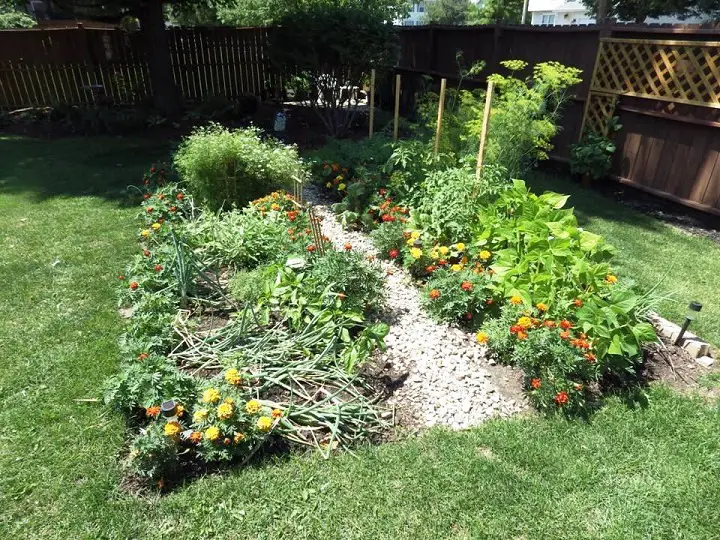
Some Science Behind the Rotations
It seems curious that any one plant would cause a depletion of a specific nutrient when all plants require them for growth, but certain plants draw different nutrients from soil that are unique from other plants. For example, leafy vegetables require more nitrogen, whereas root vegetables such as carrots need more phosphorus.
The fact is, crops belonging to the same plant family are similar in their nutrient requirements. That’s important to know because you may think you are planting a different crop when rotating, but you may be planting a vegetable that has a very similar root system and draws the same nutrients as its previous family member. The plants may be different, but they behave the same way because they’re from the same family.
Some plants have deep roots (tomatoes) while others have shallow root systems (onions) affecting different strata and nutrient levels in soil. Plants from the same family can also be susceptible to similar diseases and fungus if planted in the same location season after season.
A good example is broccoli, which can have an adverse affect on other cruciferous vegetables like cauliflower or cabbage if they are planted in the same bed in following years.
If it’s starting to feel like a Rubik’s Cube, it is. But there’s an easy way to manage crop rotation on a small scale and maximize the health and the yields from your vegetable plants. You just need to take a little time to understand some basics about garden vegetables including:
- Know the plant families and how different plants within a family share common characteristics related to nutrient requirements, root depth, shared diseases, and other common characteristics.
- Plant the super feeders or nitrogen fixing plants that return more nitrogen to the soil than they use and are one of the primary engines of successful crop rotation.
- Keep an eye on your heavy feeders and their outsized impact on soil making crop rotation necessary.
- Remember the light feeders that have less of an impact in a garden.
- Consider cover crops and how they can add nutrients and improve soil from fall through winter into early spring.
- Understand fallow as a rotation step to treat serious problems related to disease, insects, fungus, and soil degradation. It’s a common step for farmers and sometimes a necessary step in home gardens.
- Think about variations on crop rotation including inter-season succession planting.
- Practice intercropping as another variation on rotation, allowing companion plants to support each other in-season through a symbiotic or mutually beneficial relationship.
- Take the time for plotting and planning a multi-season, multi-year master plan for your garden that uses crop rotation as a primary success factor.
If all that sounds like a lot, there’s good news. You only have to learn this once, and after that it will become second nature. If you already understand many of the nuances of crop rotation, it may be a good time to take a look at that plan and see if you can add any improvements or new practices.
1. Understanding Plant Families
Plants within a family behave in the same way when it comes to the nutrients they draw and their overall affect on soil structure. If possible, try to vary your plantings of vegetables from the same family in different locations year after year.
Plant Families for Common Home Garden Crops
| Plant Family | Common Crops | Uncommon Crops |
|---|---|---|
| Amaranth Family Amaranthaceae | Spinach, beet, Swiss chard | Pigweed, celosia, quinoa, sugar beet |
| Onion Family Amaryllidaceae | Onion, leek, garlic, chive | Daffodil |
| Parsley Family Apiaceae | Carrot, parsley, celery, cilantro (coriander), fennel, dill | Cumin |
| Sunflower Family Asteraceae | Lettuce, artichoke (hearts), Jerusalem artichoke, endive, sunflower | Zinnia, marigold, chrysanthemums, ragweed, dandelion, daisy, Stevia |
| Cabbage Family Brassicaceae | Collard, kale, cabbage, broccoli, mustard, turnip, radish, cauliflower, Brussels sprouts, arugula | Canola, horseradish, sweet alyssum, wasabi |
| Morning Glory Family Convolvulaceae | Sweet potato | Morning glory |
| Cucurbit Family Cucurbitaceae | Squash, zucchini, cucumber, watermelon, cantaloupe, honeydew, pumpkin | Luffa, gourd |
| Mint Family Lamiaceae | Mint, basil, rosemary, oregano, sage, thyme | Salvia, lavender, catnip |
| Bean Family Leguminosae | Bean, pea, peanut | Soybean |
| Mallow Family Malvaceae | Okra | Cotton, hibiscus |
| Grass Family Poaceae | Sweet corn | Wheat, oats, rye, barley, sugar cane, rice |
| Nightshade Family Solanaceae | Tomato, pepper, eggplant, Irish potato | Tobacco, petunia |
Stop and take a look at this chart as you plan your garden and try to change or “rotate” crops from different families in the same location from season to season. As we get into it, you’ll see there’s more to crop rotation than just changing out plants from the same family in the same location over the seasons.
2. Remember the Super Crops

When it comes to crop rotation, legumes are the rotation heroes. Legumes are a family of plants largely defined by beans and peas. What’s unique about legumes is that they use nitrogen fixing bacteria to draw nitrogen from the atmosphere and “fix” it into the soil to feed the plant.
Better yet, legumes fix an excess of nitrogen into the soil beyond what the legume needs. This naturally replenishes the soil, allowing for bumper crops of any other crop planted in that location the following season.
Here are some of the specific legumes that fix nitrogen into the soil:
- Black beans
- Black-eyed peas
- Chickpeas, also called garbanzo beans
- Great Northern beans
- Green beans (Bush and Pole type)
- Green peas (Snap peas, Flat peas, Sweet peas and all others)
- Kidney beans
- Lentils
- Lima beans
- Navy beans
- Peanuts
- Pinto beans
- Soybeans
- Yellow (Wax) beans
On a commercial scale, soybeans are the crop most often rotated into fields by farmers to replenish nutrients consumed by corn, wheat, and other heavy feeding grass and grain crops.
Home gardeners usually use bush and pole beans in addition to various types of green peas to replenish their gardens. If you do nothing else with crop rotation, at least plant a lot of beans and peas over the years.
3. The Heavy Feeders
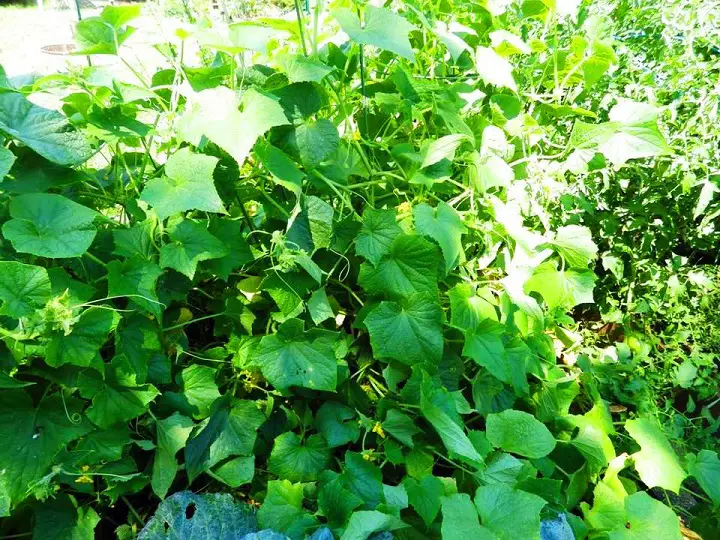
Problems with soil depletion occur rapidly with certain plants or crops. These plants are known as “heavy feeders.” They consume significant quantities of soil nutrients (especially nitrogen) and without crop rotation require applications of artificial (chemical) fertilizers or future crop yields will continually decrease.
The addition of organic fertilizer (compost) is ideal but crop rotation is a smart move to manage your heavy feeders.
Here are some of the heavy feeders that really require crop rotation in a home garden or any area of planting:
- Broccoli
- Celery
- Corn
- Cucumbers
- Eggplant
- Melons
- Okra
- Peppers
- Pumpkins
- Squash
- Tomatoes
- Tomatillos
Any one vegetable from this group of plants should not be planted in the same location that any other heavy feeder was growing the previous season. Think in terms of legumes as a follow-up crop, or at the least add compost or plant vegetables from a group of plants known as “light feeders.”
4. The Light Feeders

Light feeders don’t exhaust soil nutrients as much as the heavy feeders. And while they don’t have the nitrogen fixing capability of legumes, they don’t require significant revitalization after a season.
Light feeders are mostly defined as root vegetables and because they depend on phosphorous more than nitrogen for growth can do well if planted in a spot previously occupied by a heavy feeder.
Light feeders include:
- Bulbs in general
- Carrot
- Garlic
- Herbs (mostly due to the fact that they tend to be smaller plants)
- Leeks
- Onions
- Parsnip
- Potatoes
- Rutabaga
- Shallots
- Turnips
5. Cover Crops
Cover cropping is a standard practice with large scale farming and can be easily done, although may not be necessary in a small-scale home garden. They’re mostly intended for larger efforts up to a half acre or more. They help in any size garden, but whether or not you cover crop in a small garden is up to you.
Cover crops are grains, grasses, or legumes that will grow during fall and winter and that you can cut or till under in the spring to build better soil for gardening. You’re not planting cover crops for harvest, they’re just to add nutrients to the soil when tilled in the spring.
During their growth, cover crops help break up compacted soil and prevent erosion. Their roots penetrate and help loosen heavy clumps of soil, allowing air and water to more easily move through your garden. When you turn cover crops under, they add organic matter to the soil—building better soil structure and fertility.
Here are some good tips for cover cropping:
Step 1: Choose a Cover Crop
Deciding what vegetables you want to plant in the spring can help you choose a cover crop. If you intend to plant early vegetables in March, plant a grass cover crop such as rye grass, oat, or wheat, the preceding fall.
These cover crops can provide sufficient soil cover for the winter and significant growth before they need to be terminated to make room for vegetable planting.
If you are going to plant vegetable crops in April or early May, a legume winter cover crop like crimson clover or vetch will have enough time to grow and provide a nitrogen benefit. Legumes like peas will provide even more nitrogen if the vegetable crop is not planted until late May or June.
You can also mix cover crops together, which is especially helpful if you have a little bit of a few different seeds on hand.
Step 2: Prepare the Garden Bed
Remove any annual plant remains or weeds that are in the garden plot or bed at the end of the growing season. Since your garden has been busy producing all summer, it’s good to add some nutrients to the soil before planting to ensure the cover crops will thrive. Use compost.
Step 3: Plant the Seeds
Plant your cover crop early enough to permit 4 weeks of growth before cold weather stops that growth. After preparing the soil, you can plant large-seeded cover crops (peas, vetch and wheat) in shallow, closely spaced furrows.
Broadcast small-seeded crops (ryegrass, buckwheat) over the surface and cover with a light raking. If the soil is dry, water to ensure the seeds germinate.
Step 4: Finishing the Cover Crop
In the spring, about three weeks before you plant spring crops, turn the cover crop under and allow the organic matter to decompose. If the cover crop is too tall to turn under easily, cut it first.
If you will be transplanting vegetable seedlings or planting vegetable crops with large seeds, such as beans or corn, you can cut and leave some mowed cover crop on the surface as mulch, rather than mixing it all into the soil.
Don’t allow cover crops to go to seed. Prevent them from competing with your food crop.
6. And Then There’s “Fallow”
Home gardeners usually don’t leave a garden unplanted for a season, but that’s what leaving a field or garden “fallow” is all about. Fallow is a farming technique in which arable land is left without sowing for one or more crop cycles.
The goal of fallowing is to allow the land to recover and store organic matter while retaining moisture and disrupting pest life cycles and soil borne pathogens by temporarily removing their hosts.
The most common reason someone would leave a home garden section or area fallow is to deal with a chronic disease or pest problem that seems incurable. Some fungus varieties are hard to kill, and the only way to break the cycle is to simply not plant anything for a year.
That’s rare, but if you have a problem with a fungus, pest, or disease that defies all treatments, leaving things fallow may be the only solution. Otherwise, you don’t have to take this extreme step at least in a small-scale, home garden.
Creative Variations on Crop Rotation
Most crop rotation practices occur from one growing season to the next. However, there are some ways to engage crop rotation within the same season using either succession planting or intercropping.
7. Succession Planting
Many vegetable varieties mature quickly. Radishes are a good example and can reach maturity within 30 days. Snap peas are another example and can be fully harvested after 45 days with some varieties. What many gardeners do is plant a second and even a third planting in the same space previously occupied by the fast maturing vegetables.
What’s critical is to not succession plant the same plant in the same location. After you harvest your radishes, plant those peas. After your lettuce is harvested, plant some beets.
Remember to try and succession plant vegetables from different plant families, and always remember that peas and beans put nitrogen back into the soil. Legumes you can plant in the same spot again and again.
The better news with succession planting is that most fast maturing plants are either light feeders or, in the case of snap peas and bush beans, nitrogen fixing plants that enrich the soil as they grow.
You’ll obviously need to plant a second or succeeding crop that also matures quickly before the season ends, but stick with the light feeders or nitrogen fixers for your succession crops.
What you’re essentially doing is rotating crops within the same season using succession planting with fast maturing varieties. If you have a longer growing season, you could expand the types and varieties of vegetables with longer maturity rates, but always remember to try and rotate different crops in the same locations.
Even if you’re planting legumes again and again, shift from bush beans to snap peas to pole beans.
8. Intercropping
An interesting gardening concept is defined as companion planting and that concept can allow you to reap the benefits of crop rotation in the same season through “intercropping.”
Companion planting is a designed effort to put plants together that are compatible, and in some instances benefit each other. Once you’ve determined which plants are good companions, you can inter-plant or intercrop both plants and realize some of the benefits of crop rotation within the same season.
Where intercropping crosses over to crop rotation is when two vegetables have a symbiotic relationship. This means they help each other in various ways due to their close proximity within a shared space.
A good example is carrots planted underneath tomato plants or pole beans planted with a heavy feeder like cucumbers.
In both instances, one crop towers over the other, but pole beans growing vertically over cucumbers spreading on the ground horizontally means they are sharing the same space without competing with each other for sunlight. And carrots don’t mind growing in the shade under tomatoes, and neither do onions.
Another example is when a tall growing vegetable like staked pole beans or cucumbers serve to create shade for shade-loving cruciferous plants like cabbage.
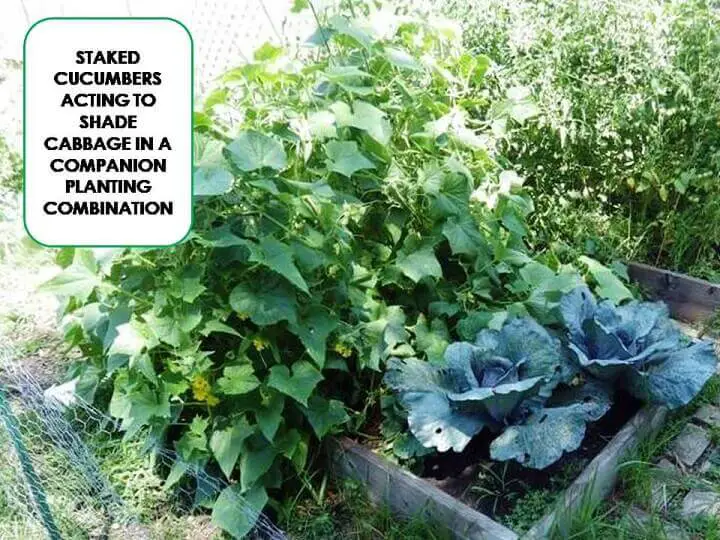
Intercropping gives you many of the benefits of crop rotation in the same season, as long as the two vegetables are compatible companions. It’s also important to try to intercrop plants from different plant families so check your charts.
Here’s another chart of vegetable plants that help each other as companions or when intercropped, and some combinations to avoid:
Vegetable Companion Planting Chart
| Plant | Good Companion | Bad Companion |
|---|---|---|
| Basil | Pepper, tomato, marigold | None |
| Bush beans | Beets, cabbage, carrots, cauliflower, celery, chard, corn, cucumbers, eggplant, leek, lettuce, parsnip, potato, radish, rosemary, strawberry, savory, sunflower, tansy, marigold | Basil, fennel, kohlrabi, onion |
| Pole beans | Carrots, cauliflower, chard, corn, cucumber, eggplant, lettuce, marigold, pea, potato, radish, rosemary, savory, strawberry, tansy | Basil, beets, cabbage, fennel, kohlrabi, onion, radish, sunflower |
| Beets | Bush beans, cabbage family, lettuce, lima bean, onion, radish, sage | Mustard, pole bean |
| Cabbage family including broccoli | Bush beans, beets, carrot, celery, cucumber, dill, lettuce, mint, nasturtium, onions, rosemary, sage, spinach, thyme, all strong herbs, marigold, nasturtium | Pole beans, strawberry, tomato |
| Carrots | Beans, Brussels sprouts, cabbage, chives, lettuce, leek, onion, peas, radish, rosemary, sage, tomato | Celery, dill, parsnip |
| Celery | Just about everything… | …except carrots, parsley and parsnips |
| Corn | All beans, beets, cabbage, cantaloupe, cucumber, lemons, parsley, peas, early potatoes, pumpkin, squash | Tomatoes |
| Cucumbers | Bush beans, pole beans, cabbage family, corn, dill, eggplant, lettuce, marigold, nasturtium, onions, peas, radish, tomato, savory, sunflower, no strong herbs | potato |
| Eggplant | Bush beans, pole beans, peas, peppers, potato, spinach | fennel |
| Lettuce | Everything | Nothing |
| Melon | Corn, nasturtium, radish | Potato |
| Onion | Beets, cabbage family, carrots, celery, cucumber, lettuce, parsley, pepper, spinach, squash, strawberries, tomato, turnip, savory | Asparagus, beets, peas, sage |
| Parsley | Tomato | None |
| Peas | Bush beans, pole beans, carrots, celery, chicory, corn, cucumber, eggplant, parsley, early potato, radish, spinach, strawberry, sweet pepper, turnips | Onion, late potato |
| Potato | Bush beans, cabbage family, carrot, corn, horseradish, marigold, onion, parsnip, peas | Cucumber, kohlrabi, parsnip, pumpkin, rutabaga, squash family, sunflower, turnip, fennel |
| Radish | Beets, bush beans, pole beans, carrots, cucumber, lettuce, melons, nasturtium, parsnip, peas, spinach, squash family | hyssop |
| Spinach | Celeriac, celery, corn, eggplant, cauliflower | None |
| Squash | Corn, onion, radish | None |
| Strawberry | Bush beans, lettuce, nasturtium, onion, radish, spinach | Cabbage, potato |
| Tomato | Asparagus, basil, beans, cabbage family, carrots, celery, chives, cucumber, garlic, head lettuce, marigold, mint, nasturtium | Pole beans, corn, dill, fennel, potato |
9. Plotting and Planning
It’s easy to chart a garden, and for most people actually fun. It’s usually a wintertime activity as you get ready for the first preps of spring, but it can also be done with an existing garden to make an ideal planting guide for next year.
What you’re going to do is a 4 year plan. It will identify what you want to grow in your first year and then identify how to best rotate crops as the seasons and the years go on. It can also give you a reminder for where and when to succession plant, intercrop, or make adjustments as the years go on.
You can also keep track of what you may choose to use as a cover crop over the winter and to keep notes on problems that may require you to leave part of your garden or an entire garden fallow for a season. Hopefully that never happens.
It’s not as hard as it sounds and once it’s done, it will make planning and planting year after year not only easy but potentially more successful.
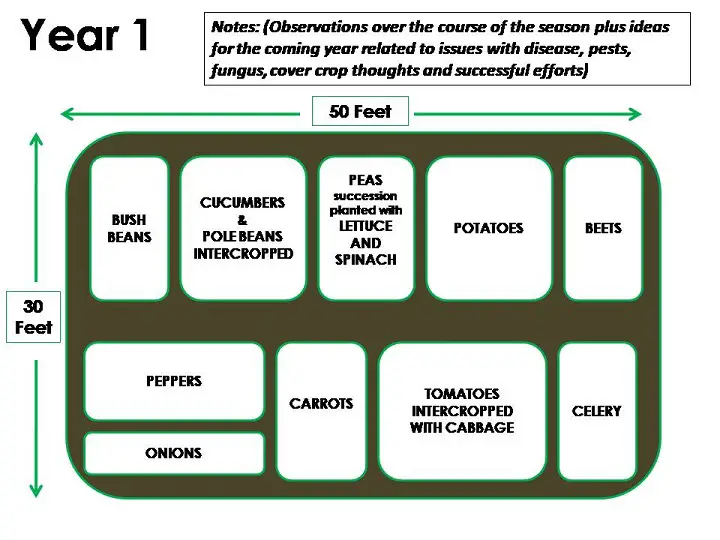
Year 1 sets the stage for future crop rotation. Your choice of vegetables will most likely vary, but remember that any vegetables planted next to others or intercropped should be compatible.
Also try to vary vegetables from different families from one year to the next. The critical thing is to make sure you follow or precede the planting of any heavy feeders with nitrogen fixers like beans or peas.

A comparison of year 1 and year 2 demonstrates how heavy feeders are followed by nitrogen fixers and continues to demonstrate intercropping and succession planting.
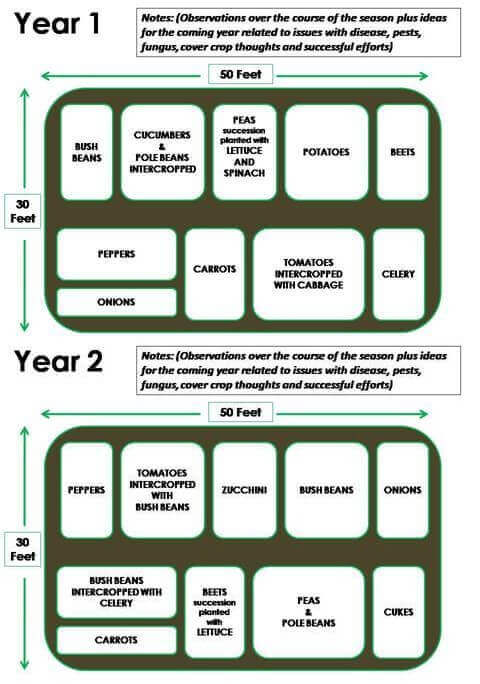
Once again, vegetable plots next to each other are also mindful of beneficial companions.
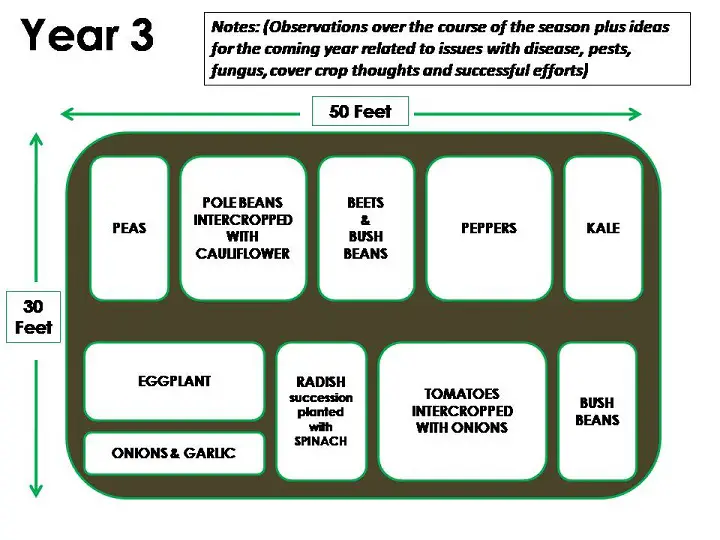
Year 3 continues to demonstrate how plantings are varied to revitalize nutrients and there’s always the opportunity to introduce new vegetable varieties to the garden.

Just keep an eye on the heavy feeders and companions as you vary your crops.
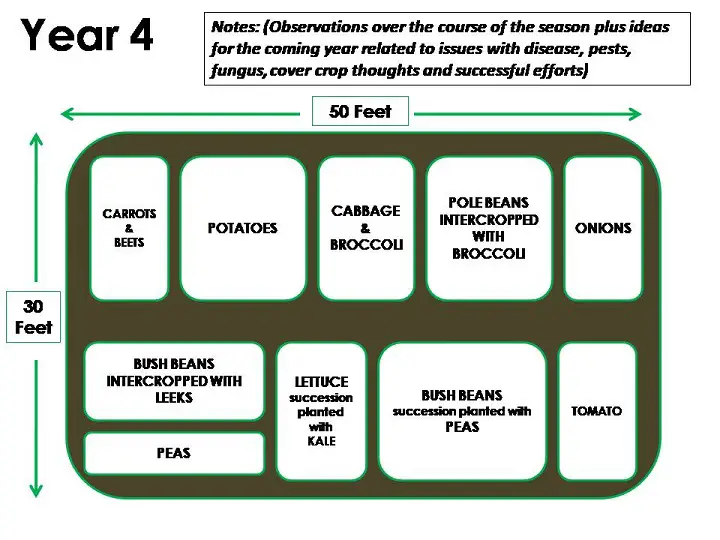
Year 4 continues the pattern of alternating crops to compensate for previous plantings of heavy feeders and enriched soil from nitrogen fixers.

Intercropping and succession planting can go beyond what we’ve indicated as long as the plants are compatible companions with surrounding plants.
You can easily continue this plan into succeeding years and develop new plans as you increase the size or locations of additional gardens.
Is Crop Rotation Really Necessary?
If you aggressively and proactively garden year after year, you will no doubt see a fall off in yields and plant health without some level of crop rotation. Adding compost or even chemical fertilizers could compensate, but with the rising costs of fertilizer, that may just add more costs to your gardening efforts.
At a bare minimum, just varying planting locations of heavy feeders and nitrogen fixers can go a long way towards revitalizing a garden. If you pursue it beyond the basics to managing companion planting, proper succession planting, intercropping, cover cropping, and the addition of compost, you’ll get the maximum yields from any sized garden.
Better yet, you’ll maintain a healthy garden environment that will largely maintain itself simply because you took the time to learn a bit about crop rotation.
Like this post? Don't Forget to Pin It On Pinterest!

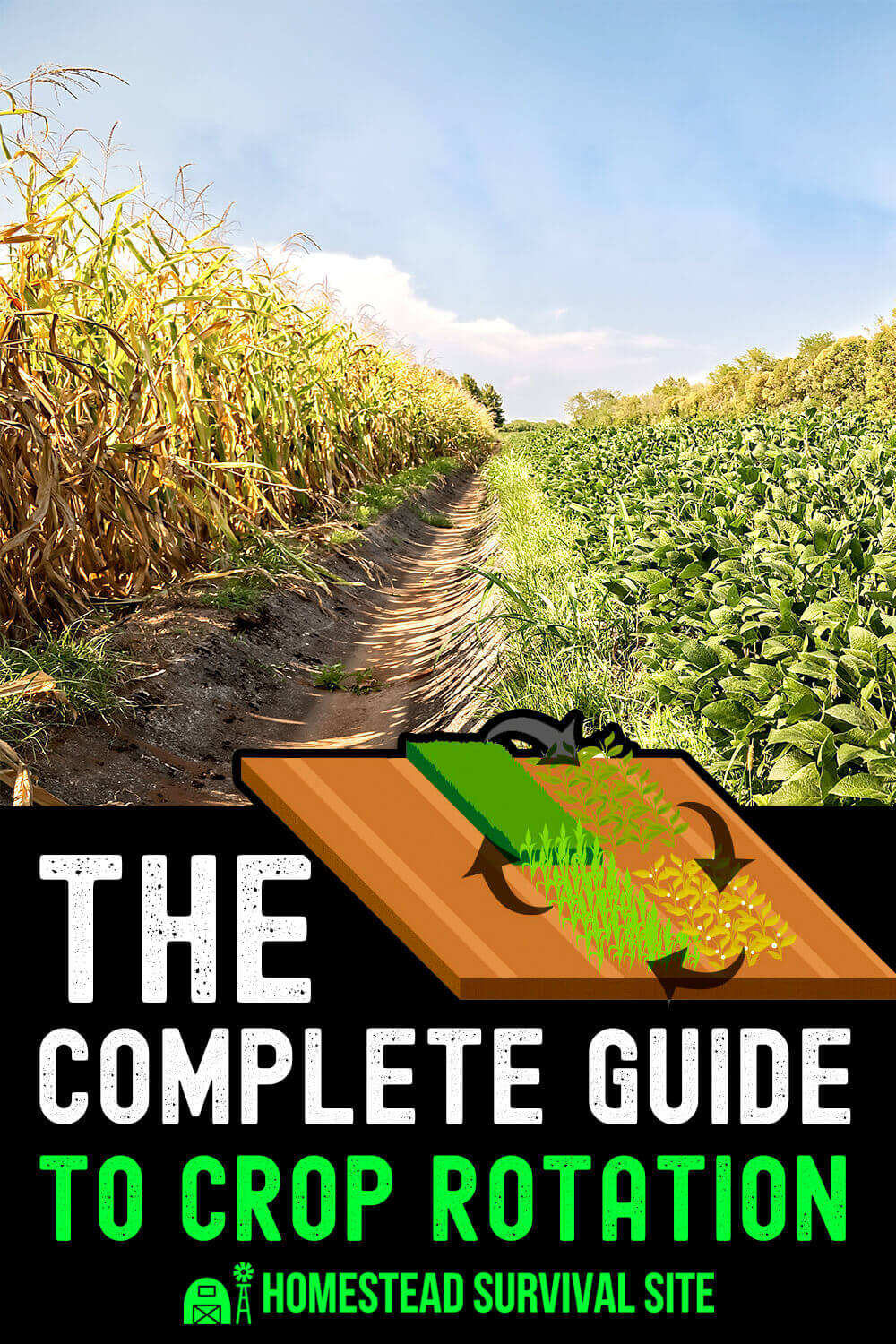


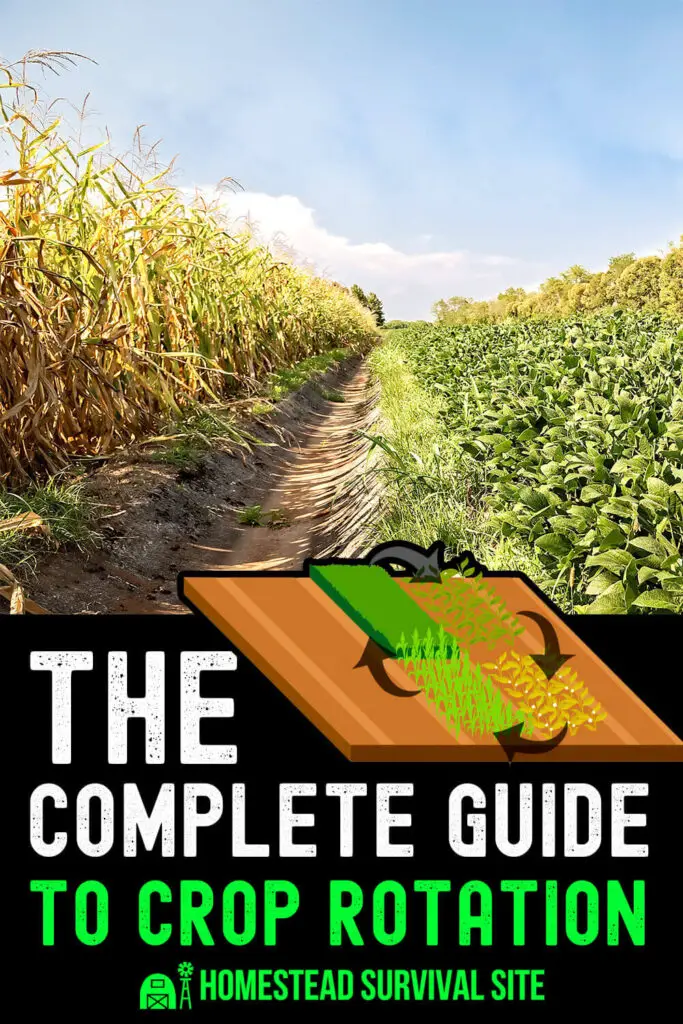





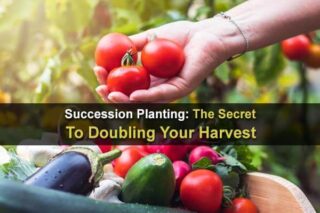


I have some fruit bearing plants that are perennials, they continue to thrive where they are. Specifically, Rue, Thyme and Sage. They are all winter hardy, so I have no need to move or switch them out. I keep this herb bed lightly mulched and it has been doing well for a few years. Is this a reason to move it? I see no need.
Regardless of crop rotation, fallow, etc., constantly removing crops, without somehow replacing the various micronutrients each crop contains, will deplete the soil.